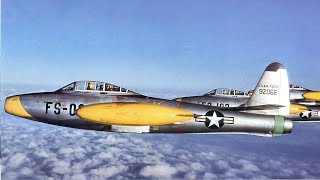At the height of the Korean War, the F-84 Thunderjet was developed to be the P-47 Thunderbolt,’s successor. Soon, the aircraft would find itself face to face with its most deadly adversary, the Soviet-built MiG-15.
Outmatched, outpaced, but never outdone, this jet created a legacy of its own.
Beginnings
In 1944, Alexander Kartveli, the mastermind behind the iconic P-47 Thunderbolt wanted to create a jet-powered successor. Thus, the innovative XP-84 Thunderjet with a J-35 turbojet running through the fuselage, and fuel stored in sleek wingtip tanks.
Drawbacks
The F-84B and F-84C models showed structural failings. The model that emerged as the Thunderjet’s savior was the F-84D. It featured sturdier wing spars, revised fuel tanks, a functional ejection seat, and a more powerful J-35A-17 engine.
Other Features
The Thunderjet shared similarities to the P-47 in its heavy-feeling nature and high takeoff and landing speeds.
It had a striking figure with a tubular fuselage, circular air dominating the nose, and the pilot’s position to provide an impressive all-around view. Armed with six rapid-firing M3 0.50 caliber machine guns, it can also carry a formidable payload of rockets and bombs.
In The Skies of Korea
The Thunderjet played a key role in the Korean War. While a formidable fighter of its own, when faced against more experienced Soviet pilots, the F-84’s advantage diminished. Despite this, this type would fare well in the majority of the encounters during the Korean War.
Outgunned and Outnumbered
The Thunderbolt would then find itself face to face with its deadly adversary the Soviet-built MiG-15 on a cold winter morning of January 21, 1951, over the skies of North Korea. The dogfight ensued.
Despite being outmatched by a more advanced enemy aircraft, the F-84s managed to down 105 MiG-15s with eight enemy aircraft shot down and confirmed during the war.



